Gail E. Tverberg
Economic growth never seems to be as high as those making forecasts would like it to be. This is a record of recent forecasts by the International Monetary Fund:
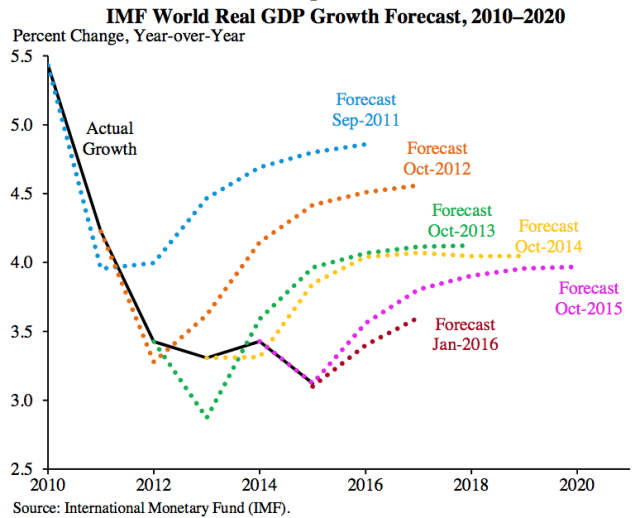
Figure 1. World GDP Forecasts by the International Monetary Fund.
Figure 2 shows world economic growth on a different basis–a basis that appears to me to be very close to total world GDP, as measured in US dollars, without adjustment for inflation. On this basis, world GDP (or Gross Planetary Product as the author calls it) does very poorly in 2015, nearly as bad as in 2009.

Figure 2. Gross Planet Product at current prices (trillions of dollars) by Peter A. G. van Bergeijk in Voxeu, based on IMF World Economic Outlook Database, October 2015.
The poor 2015 performance in Figure 2 reflects a combination of falling inflation rates, as a result of falling commodity prices, and a rising relativity of the US dollar to other currencies.
Clearly something is wrong, but virtually no one has figured out the problem.
The World Energy System Is Reaching Limits in a Strange Double Way
We are experiencing a world economy that seems to be reaching limits, but the symptoms are not what peak oil groups warned about. Instead of high prices and lack of supply, we are facing indirect problems brought on by our high consumption of energy products. In my view, we have a double pump problem.

Figure 3. Double gasoline pump from Torrence Collection of Auto Memorabilia.
We don’t just extract fossil fuels. Instead, whether we intend to or not, we get a lot of other things as well: rising debt, rising pollution, and a more complex economy.
The system acts as if whenever one pump dispenses the energy products we want, another pump disperses other products we don’t want. Let’s look at three of the big unwanted “co-products.”
1. Rising debt is an issue because fossil fuels give us things that would never have been possible, in the absence of fossil fuels. For example, thanks to fossil fuels, farmers can have such things as metal plows instead of wooden ones and barbed wire to separate their property from the property of others. Fossil fuels provide many more advanced capabilities as well, including tractors, fertilizer, pesticides, GPS systems to guide tractors, trucks to take food to market, modern roads, and refrigeration.
The benefits of fossil fuels are immense, but can only be experienced once fossil fuels are in use. Because of this, we have adapted our debt system to be a much greater part of the economy than it ever needed to be, prior to the use of fossil fuels. As the cost of fossil fuel extraction rises, ever more debt is required to place these fossil fuels in use. The Bank for International Settlements tells us that worldwide, between 2006 and 2014, the amount of oil and gas company bonds outstanding increased by an average of 15% per year, while syndicated bank loans to oil and gas companies increased by an average of 13% per year. Taken together, about $3 trillion of these types of loans to the oil and gas companies were outstanding at the end of 2014.
As the cost of fossil fuels rises, the cost of everything made using fossil fuels tends to rise as well. Cars, trucks, and homes become more expensive to build, especially if they are intended to be energy efficient. The cost of capital goods purchased by businesses rises as well, since these too are made with fossil fuels. Needless to say, the amount of debt to purchase all of these goods rises as well. Part of the reason for the increased debt is simply because it becomes more difficult for businesses and individuals to purchase needed goods out of cash flow.
As long as fossil fuel prices are rising (not just the cost of extraction), this rising debt doesn’t look like a huge problem. The rising fossil fuel prices push the general inflation rate higher. But once prices stop rising, and in fact start falling, the amount of debt outstanding suddenly seems much more onerous.
2. Rising pollution from fossil fuels is another issue as we use an increasing amount of fossil fuels. If only a tiny amount of fossil fuels is used, pollution tends not to be much of an issue. Air can remain safe for breathing and water can remain safe for drinking. Increasing CO2 pollution is not a significant issue.
Once we start using increasing amounts, pollution becomes a greater issue. Partly this is the case because natural sinks reach their saturation point. Another is the changing nature of technology as we move to more advanced techniques. Techniques such as deep sea drilling, hydraulic fracturing, and arctic drilling have pollution risks that less advanced techniques did not have.
3. A more complex economy is a less obvious co-product of the increasing use of fossil fuels. In a very simple economy, there is little need for big government and big business. If there are businesses, they can be run by a small number of individuals, with little investment in capital goods. A king, together with a handful of appointees, can operate the government if it does not provide much in the way of services such as paved roads, armies, and schools. International trade is not a huge necessity because workers can provide nearly all necessary goods and services with local materials.
The use of increasing amounts of fossil fuels changes the situation materially. Fossil fuels are what allow us to have metals in quantity–without fossil fuels, we need to cut down forests, use the trees to make charcoal, and use the charcoal to make small quantities of metals.
Once fossil fuels are available in quantity, they allow the economy to make modern capital goods, such as machines, oil drilling equipment, hydraulic dump trucks, farming equipment, and airplanes. Businesses need to be much larger to produce and own such equipment. International trade becomes much more important, because a much broader array of materials is needed to make and operate these devices. Education becomes ever more important, as devices become increasingly complex. Governments become larger, to deal with the additional services they now need to provide.
Increasing complexity has a downside. If an increasing share of the output of the economy is funneled into management pay, expenditures for capital goods, and other expenditures associated with an increasingly complex economy (including higher taxes, and more dividend and interest payments), less of the output of the economy is available for “ordinary” laborers–including those without advanced training or supervisory responsibilities.
As a result, pay for these workers is likely to fall relative to the rising cost of living. Some would-be workers may drop out of the labor force, because the benefits of working are too low compared to other costs, such as childcare and transportation costs. Ultimately, the low wages of these workers can be expected to start causing problems for the economic system as a whole, because these workers can no longer afford the output of the system. These workers reduce their purchases of houses and cars, both of which are produced using fossil fuels and other commodities.
Ultimately, the prices of commodities fall below their cost of production. This happens because there are so many of these ordinary laborers, and the lack of good wages for these workers tends to slow the “demand” side of the economic growth loop. This is the problem that we are now experiencing. Figure 4 below shows how the system would work, if increasing complexity were not interfering with economic growth.
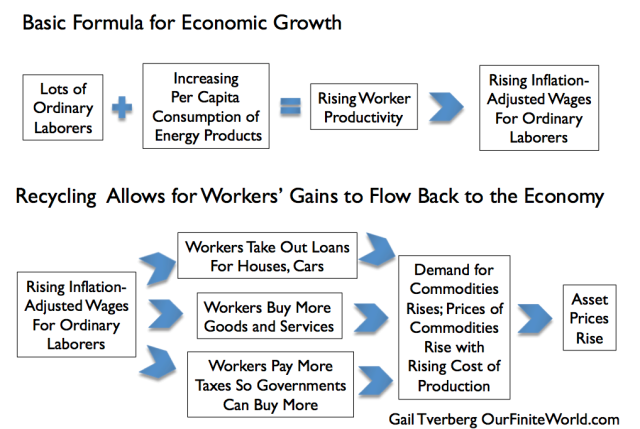
Figure 4. How economic growth works, if increased complexity is not interfering.
Also see my post, How Economic Growth Fails.
The Two Pumps Are Really Energy and Entropy
Unlike the markings on the pump (gasoline and ethanol), the two pumps of our system are energy consumption and entropy. When we think we are getting energy consumption, we really get various forms of entropy as well.
The first pump, rising energy consumption, seems to be what makes the world economy grow.
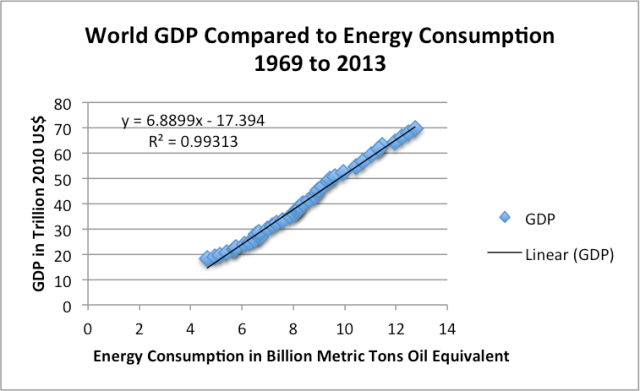
Figure 5. World GDP in 2010$ compared (from USDA) compared to World Consumption of Energy
(from BP Statistical Review of World Energy 2014).
This happens because the use of energy products allows businesses to leverage human labor, so that human labor can be more productive. A farmer with a stick as his only implement cannot produce much food, but a farmer with a tractor, gasoline, modern implements, hybrid seeds, irrigation, and access to modern roads can be very productive. This productivity would not be available without fossil fuels. Figure 4, shown earlier, describes how this increased productivity usually gets back into the system.
The second pump in Figure 3 is Entropy Production. Entropy is a measure of the disorder associated with the extraction and consumption of fossil fuels and other energy products. Entropy can be thought of as a loss of information. Once energy products are burned, we have a portion of GDP in the place of the energy products that have been consumed. This is why there is a high correlation between energy consumption and GDP. As energy products are burned, we also have an increasing pile of debt, increasing pollution (that our sinks become less and less able to handle), and increasing wealth disparity.
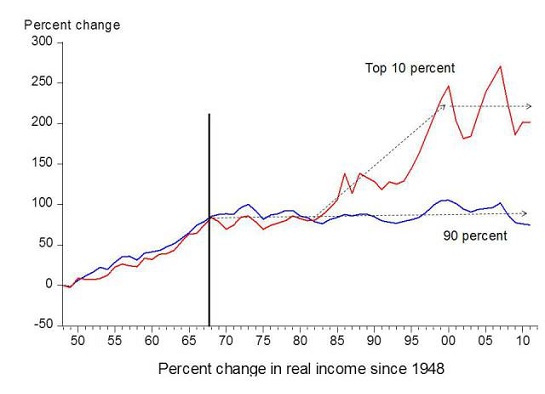
Figure 6. Difference in US income growth patterns of the top 10% versus the bottom 90%. Chart by economist Emmanuel Saez based on an analysis of IRS data, published in Forbes.
Beyond the three types of entropy I have mentioned, there are other related problems. For example, the current immigration problem is at least partly a problem associated with increased complexity and thus increased wealth disparity. Also, low oil prices are a sign of a loss of “information,” and thus also a sign of growing entropy.
Our Energy/Entropy System Operates on an Energy Flow Basis
I think of two different kinds of accounting systems:
With respect to energy, we burn fossil fuels in a given year, and we obtain output of renewable energy devices in a given year. We eat food that has generally been grown in the year we eat it. There is virtually no accrual aspect to the way the system works. This is very different from the accrual-basis financial statements prepared by most large companies that allow credit for investments before the benefit is actually in place.
When it comes to promises such as Social Security benefits, we are, in effect, promising retirees a share of energy production in future years. The promise is only worth something if the system continues to work well–in other words, if the financial system has not collapsed, pollution is not too great a problem, and marginalized workers are not revolting.
Governments can print money, but they can’t print resources. It is the resources, particularly energy resources, that we need to run the economy. In fact, we need per capita resources to be at least flat, or perhaps increasing.
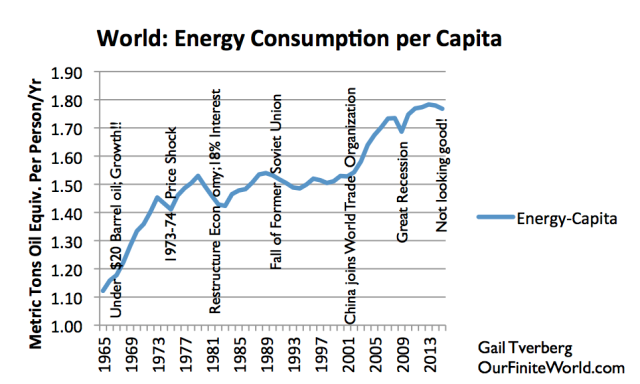
Figure 7. World energy consumption per capita, based on BP Statistical Review of World Energy 2105 data.
Year 2015 estimate and notes by G. Tverberg.
Printing money is an attempt to get a larger share of the world’s resources for the population of a given country. Printing money usually doesn’t work very well, because if a country prints a lot of money, the currency of that country is likely to fall relative to currencies of other countries.
What Causes the System to Fail? Too Little Energy, or Too Much Entropy?
In an interconnected system, it is sometimes hard to understand what causes the system to fail. Is it too little production of energy products, or too much entropy associated with these energy products? Astrophysicist Francois Roddier tells me that he thinks it is too much entropy that causes the system to fail, and I tend to agree with him. (See also “Pourquoi les économies stagnant et les civilizations sʼeffondrent” by Roddier in Économie de l’après-croissance.) The rising amount of debt, pollution, and income inequality tend to bring the system down, long before “running out” of energy products becomes a problem. In fact, the low commodity prices we are now experiencing appear to be part of the entropy problem as well.
Can Renewable Energy Be a Solution?
As far as I can see, renewable energy, unless it is very cheap (like hydroelectric dams were many years ago), absolutely does not work as a solution to our energy problems. The basic issue is that the energy system works on a flow year basis. To match energy-in versus energy-out, we need to analyze each year separately. For example, we need to match energy going into making offshore wind turbines against energy coming out of offshore wind turbines, for each calendar year (say 2016). To keep the net energy flow positive, there needs to be an extremely slow ramp-up of high-cost renewable energy.
In a way, high-cost renewable energy is very close to entropy-only energy. Because of the high front-end energy consumption and the slow speed at which it is paid back, high-priced renewable energy generates very little energy, net of energy going into its production. (In some instances, renewable energy may actually be an energy sink.) Instead, renewable energy generates lots of entropy-related products, including increased debt and increased taxes to pay for subsidies. It also adds to the complexity of the system, because of the variable nature of its output. Perhaps renewable energy is less bad at generating pollution, or maybe the pollution is simply of a different type. Ultimately, it is a problem, just as any other type of supplemental energy is.
One problem with so-called renewable energy is that it can’t be expected to outlast the system as a whole, unless it is part of some off-grid system with backup batteries and an inverter. Even then, the lifetime of the whole system is limited to the lifetime of the shortest-lived necessary component: solar panels, battery backup, inverter, and the device the user is trying to run with the system, such as a water pump.
There are currently many stresses on our economic system. We can’t be certain that the system will last very long. When the system starts collapsing, it is likely to take grid-connected electricity systems with it.
What Is the Connection to Energy Returned on Energy Invested (EROEI)?
If a person believes that energy is a one pump system (the left pump in Figure 3), then a person’s big concern is “running out.” If a person wants to maximize the benefit of energy resources, he will choose energy resources with as high an EROEI as possible. In other words, he will try to get as much energy out per unit of energy in as possible. For example, one estimate gives EROEI of 100 to 1 for hydroelectric, 80 to 1 for coal, and much lower ratios for other fuels. Thus, a mix that is heavy in hydroelectric and coal will stretch energy supplies as far as possible.
Another place where EROEI is important is in determining “net” energy, that is, energy net of the energy going into making it.
As I mentioned above, energy per capita needs to be at least level to keep the economy from collapsing. In fact, net energy per capita probably needs to be slightly increasing to keep the economy growing sufficiently, if “net” energy is adjusted for all of the effects that simultaneously impact the energy needs of the economy, apart from energy used in producing “normal” goods and services. (Most people are not aware of the economy’s growing need for energy supplies. For an explanation regarding why this is true, see my recent post The Physics of Energy and the Economy.)
In theory, EROEI analyses might be helpful in determining how much gross energy is necessary to produce the desired amount of net energy. In practice, there are many pieces that go into determining the total quantity of net energy required to keep the economy expanding, making the calculation difficult to perform. These include:
1.The extent to which population is rising.
2.The extent to which globalization is taking place, and with it, access to other, higher EROEI, energy supplies.
3.The extent to which the economy is getting more efficient in its use of energy.
4.The extent to which EROEI is falling for various fuels (on a calendar year basis).
5.The extent to which average EROEI is falling, because the mix of fuel is changing to become less polluting.
6. The extent to which it is taking more energy to extract other resources, such as fresh water and metals.
7.The extent to which it is taking more energy to make pollution-control devices, and workarounds for problems with energy.
Looking at Figure 5, it is not obvious that there is a need for a big adjustment, one way or another, to produce net energy from gross energy. Of course, this may be an artifact of the way GDP is measured. High-priced metals and water are treated as part of GDP, as is the cost of pollution control devices. People’s general standard of living may not be rising, but now they are paying for clean air and water, something they didn’t need to pay for before. It looks like GDP is increasing, but there is little true benefit from the higher GDP.
The one big take-away I have from Figure 7 is simply that if our goal is to get net energy to rise sufficiently, the best way to do this is to make certain that gross energy production rises sufficiently. World leaders were successful in doing this since 2001, through their globalization efforts. Of course, the new energy we got was mostly coal–bad from the points of view of pollution and workers’ wages in developed countries, but good from some other perspectives: low direct debt requirement, low complexity requirement, and high EROEI.
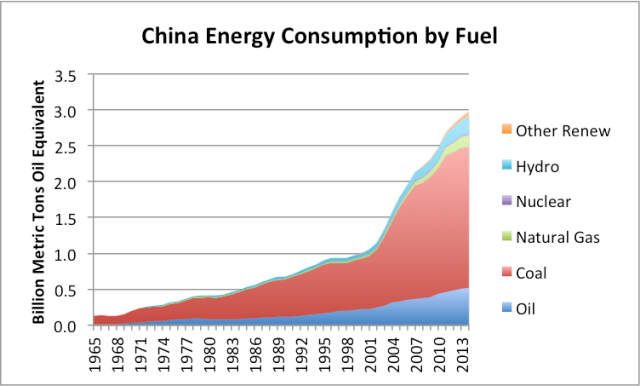
Figure 8. China’s energy consumption by fuel, based on data of BP Statistical Review of World Energy 2015.
One issue with EROEI calculations is that they disregard timing, and thus are not on an energy flow-year basis. Ignoring timing also means the calculations give little information regarding the likely debt build-up associated with an energy product.
Conclusion
If a person doesn’t understand what the problem is, it is easy to come to the wrong conclusion. Part of our problem is that we need a growing amount of net energy, per capita, to keep the economy from collapsing. Part of our problem is that entropy problems such as rising debt, increased pollution, and increasing complexity tend to bring the system down, even when we seem to have plenty of energy supplies. These are the two big problems we are facing that few people recognize.
Another part of our problem is that it is necessary for common laborers to have good-paying jobs, and in fact rising pay, if the economy is to continue to grow. As much as we would like everyone to have advanced training (and training that changes with each new innovation), the productivity of workers does not rise sufficiently to justify the high cost of giving advanced education to a large share of the population. Instead, we must deal with the fact that the world’s economy needs large numbers of workers with relatively little training. In fact, we need rising pay for these workers, because there are so many of them, and they are the ones who keep the “demand” part of the commodity price cycle high enough.
Robots may be very efficient at producing goods and services, but they cannot recycle the earnings of the system. In theory, businesses could pay very high taxes on the output of automated systems, so that governments could create make-work projects to hire all of the unemployed workers. In practice, the idea is impractical–the businesses would simply move to an area with lower taxes.
Growth now is slowing because of all of the entropy issues involved. People in China cannot stand any more pollution. Too many laborers in developed countries are being marginalized by globalization and by competition with ever-more intelligent machines that can replace much of the function of humans. None of this would be a problem, except that we have a huge amount of debt that needs to be repaid with interest, and we need commodity prices to rise high enough to encourage production. If these problems are not fixed, the whole system will collapse, even though there seems to be a surplus of energy products.